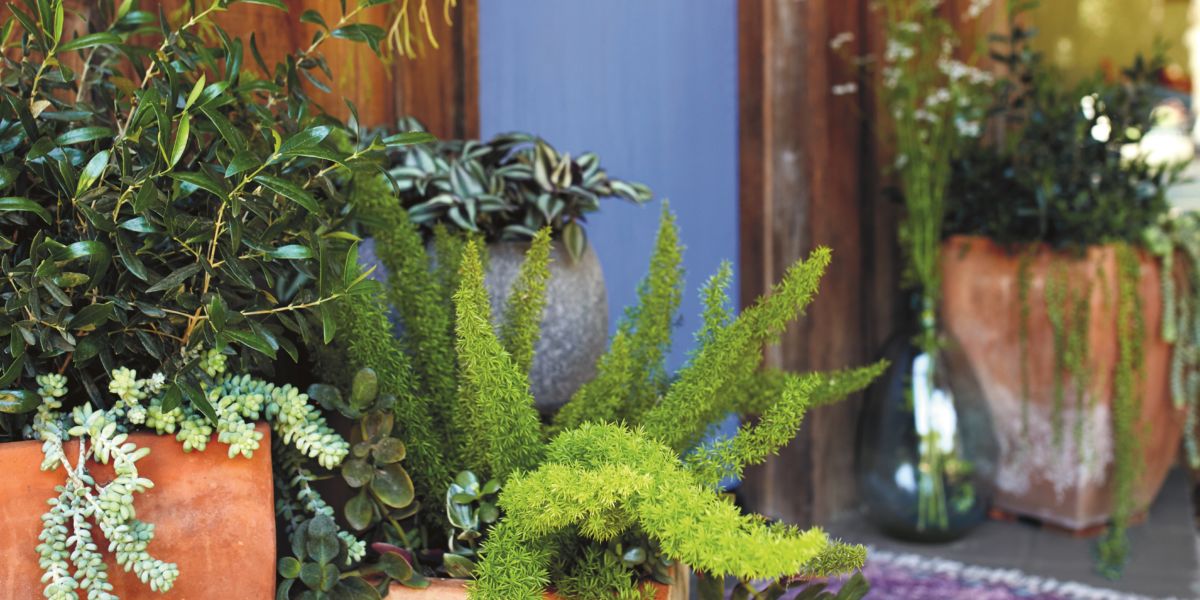
How Not to Kill Your Container Garden
Keep your potted plants alive with these 10 common sense tips from a small garden pro.

Leela Cyd courtesy of Ten Speed Press
When friends and co-authors Isa Hendry Eaton and Jennifer Blaise Kramer, a Santa Barbara-based landscape designer and writer, respectively, released their book Small Garden Style: A Design Guide For Outdoor Rooms and Containers (Ten Speed Press) in early 2020, they had no way of knowing how important outside spaces, front porches, backyards and postage-stamp sized patios would become. The Wall Street Journal reported that garden spending peaked at a wild $120 billion last year. Seed companies and nurseries across the country reported record sales. And, if we had to guess, approximately one million people stood over a sad little plant with brown-spotted or shriveled leaves and whispered “Why?”

Courtesy of Ten Speed Press
Keeping plants in containers alive and thriving starts with the planning phase. Some careful consideration before you plant—determining where a container will live, what kind of soil you should use, how much sun it will get, and how much you’re willing to pay attention to it—will make plant parenting infinitely easier.

Photo Studio by Area
1. Ask Yourself: Where Will This Container Live?
Once you know what size container you’re planting, and where it will go, you can determine which plant or plants to put in it by assessing the light exposure (south-facing is the hottest, north-facing is the shadiest) and how many hours of sun the area receives every day. South-facing plants need to be extra tough to take the heat. North-facing plants can be more delicate and are often in danger of rot if they’re over-watered.
2. Match Your Soil to Your Plants
All dirt is not created equal. Match cacti mix to succulents, veggie blend to vegetables, and use organic potting soil for everything else.
3. Plant High
Not that kind of high. The top of the soil should be within one inch of the container rim, because your plants will settle over time with watering.
4. Fertilize on a Regular Schedule
Depending on the plant’s needs, that could mean one to three times per year with liquid slow-release fertilizer. (An app like Planta can help you remember when they need feeding. )
5. Don’t Even Think about Planting in a Container Without Drainage Holes
If they aren’t included, then grab a drill and make them. Trapped water rots roots and kills plants.

Leela Cyd courtesy of Ten Speed Press
6. Set Containers on Tiles or Terraotta Feet to Encourage Good Drainage
Saucers prevent water stains on your patio, but they are one of the top causes of root rot when containers sit in standing water. Skip the saucers for a less cluttered look.
7. Fill the Entire Container with Potting Soil
Eaton does not advise filling the bottom of a container with Styrofoam, as many garden experts suggest, because that can make the container dangerously top-heavy.
8. Water on a Regular Schedule
Water depending on your plant’s specific needs (in other words, read that ugly plastic card they jam in it for directions) and let the soil dry in between waterings. If the plant fails to thrive (developing spots, or yellow or brown leaves), take a picture and bring it to the nursery to ask the pros.
9. Avoid Planting Poisonous or Thorny Plants by High-Traffic Areas
Your friends and family with thank you.

Leela Cyd courtesy of Ten Speed Press
10. Consider Planting a “Power Couple”
Put two plants together in a pot for visual interest. Choose one that grows tall (a column shape) and another that’s bushy (like a fern or a feathery flowering shrub). One of Eaton’s favorite matches is a dwarf citrus tree and hens and chicks succulents around its base, pictured above.
